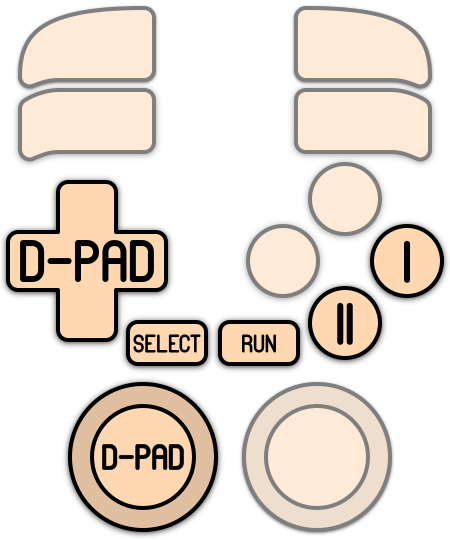PC Engine CD-ROM²/TurboGrafx-CD
The CD-ROM²/TurboGrafx-CD is an attachment to the original PC Engine/TurboGrafx-16 console developed by NEC. It was released in 1988. This made the PC Engine/TurboGrafx-16 the first videogame console ever to use CD-ROMs as storage media.
A later revision of the base console, the PC Engine Duo R (TurboDuo in the US), was released in 1991 (1992 in the US) which integrated the CD add-on into the unit and enhanced internals. This revision used a different controller port (which could still use the older controllers, but required an adapter). There would be yet another Japan-exclusive revision, the PC Engine Duo RX in 1994, which featured a six-button controller.
This system scrapes metadata for the “pcenginecd” group and loads the pce-cd set from the currently selected theme, if available.



Quick reference
- Emulator: RetroArch
- Cores available: libretro: pce, libretro: pce_fast
- Folder:
/userdata/roms/pcenginecd - Accepted ROM formats:
.pce,.cue,.ccd,.iso,.img,.chd
BIOS
This BIOS file is required.
| MD5 checksum | Share file path | Description |
|---|---|---|
38179df8f4ac870017db21ebcbf53114 | bios/syscard3.pce | Super CD-ROM2 System V3.xx |
These BIOS files can also work, however they are known to have compatibility issues with certain games:
| MD5 checksum | Share file path | Description |
|---|---|---|
bios/syscard2.pce | CD-ROM System V2.xx | |
bios/syscard1.pce | CD-ROM System V1.xx | |
bios/gexpress.pce | Game Express CD Card |
ROMs
Place your CD-ROM²/TurboGrafx-CD ROMs in /userdata/roms/pcenginecd.
To load CD-ROM content, a CUE sheet is required. CUE sheets can be recovered if lost.
The preferred format for disc compression is CHD. CHDs, by their nature, include the CUE sheet information.
Emulators
RetroArch
RetroArch (formerly SSNES), is a ubiquitous frontend that can run multiple “cores”, which are essentially the emulators themselves. The most common cores use the libretro API, so that's why cores run in RetroArch in Batocera are referred to as “libretro: (core name)”. RetroArch aims to unify the feature set of all libretro cores and offer a universal, familiar interface independent of platform.
RetroArch configuration
RetroArch offers a Quick Menu accessed by pressing [HOTKEY] + ![]() which can be used to alter various things like RetroArch and core options, and controller mapping. Most RetroArch related settings can be altered from Batocera's EmulationStation.
which can be used to alter various things like RetroArch and core options, and controller mapping. Most RetroArch related settings can be altered from Batocera's EmulationStation.
Standardized features available to all libretro cores: pcenginecd.videomode, pcenginecd.ratio, pcenginecd.smooth, pcenginecd.shaders, pcenginecd.pixel_perfect, pcenginecd.decoration, pcenginecd.game_translation
ES setting name batocera.conf_key | Description ⇒ ES option key_value |
|---|---|
| Settings that apply to all cores of this emulator | |
GRAPHICS API pcenginecd.gfxbackend | Choose which graphics API library to use. Vulkan is better, when supported. ⇒ OpenGL opengl, Vulkan vulkan. |
AUDIO LATENCY pcenginecd.audio_latency | In milliseconds. Can reduce crackling/cutting out. ⇒ 256 256, 192 192, 128 128, 64 64, 32 32, 16 16, 8 8. |
THREADED VIDEO pcenginecd.video_threaded | Improves performance at the cost of latency and more video stuttering. ⇒ On true, Off false. |
libretro: pce
libretro: pce configuration
ES setting name batocera.conf_key | Description ⇒ ES option key_value |
|---|---|
| Settings that apply to all systems this core supports | |
REDUCE SPRITE FLICKERING global.pce_nospritelimit | Enhancement. Remove the sixteen sprites per line limit. ⇒ Off disabled, On enabled. |
CONTROLLER 1 TYPE global.controller1_pce | ⇒ PCE Joypad 1, PCE Mouse 2. |
libretro: pce_fast
libretro: pce_fast configuration
ES setting name batocera.conf_key | Description ⇒ ES option key_value |
|---|---|
| Settings that apply to all systems this core supports | |
REDUCE SPRITE FLICKERING global.pce_nospritelimit | Enhancement. Remove the sixteen sprites per line limit. ⇒ Off disabled, On enabled. |
CONTROLLER 1 TYPE global.controller1_pce | ⇒ PCE Joypad 1, PCE Mouse 2. |
Controls
Here are the default CD-ROM²/TurboGrafx-CD's controls shown on a Batocera Retropad:
Troubleshooting
Further troubleshooting
For further troubleshooting, refer to the generic support pages.
- systems/pcenginecd.txt
- Last modified: 4 months ago
- by hankerde
